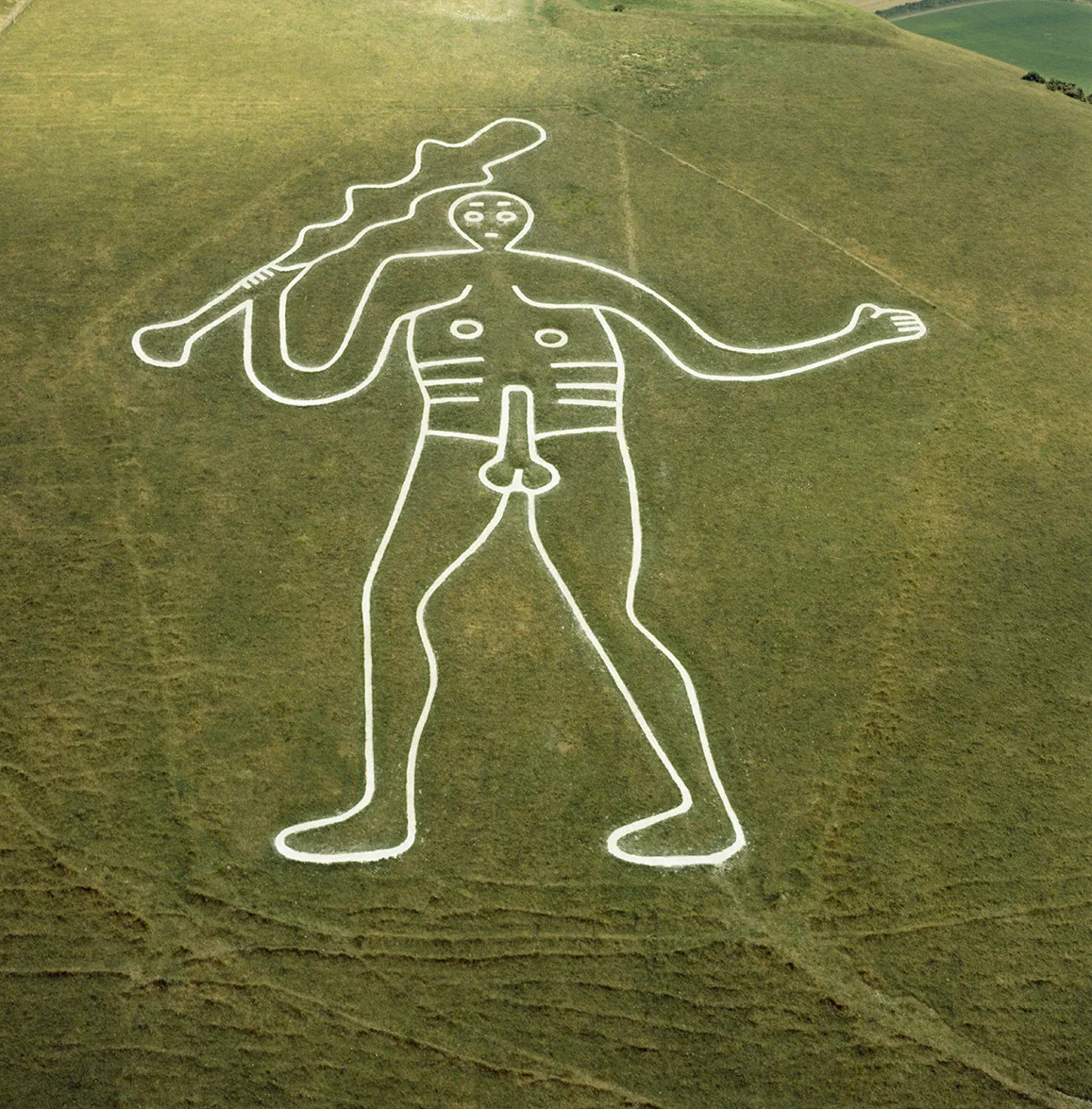Religion, Creationism, evolution, science and politics from a centre-left atheist humanist. The blog religious frauds tell lies about.
Showing posts sorted by date for query Old Dead Gods. Sort by relevance Show all posts
Showing posts sorted by date for query Old Dead Gods. Sort by relevance Show all posts
Wednesday 27 March 2024
Old Dead Gods - What Does The Cerne Abbas Giant Depict And When Was It Created?
Uncovering the mystery of Dorset’s Cerne Giant
The thing about most of the ancient monuments and hill markings like the Uffington White Horse after whom the district of Oxfordshire I live in was named, is that no-one knows what religion the people who made them believed in or how, if indeed it did, their religion inspired (or required) them to create these monuments. I have written extensively about monuments such as Stonehenge, Durrington Walls, Silbury Hill, Avebury Stone Circle and West Kennet Long Barrow as example of how little we know about these ancient people and their religion(s) because these ancient monuments stand as testament to the transient and ephemeral nature of gods and religions on the scale of human history.
Unlike science, which, if some disaster befell humankind and all memory of a major science were expunged from memory, could be reconstructed from basic principles because it describes reality, religions, once lost and forgotten are lost forever because there is nothing substantial upon which to found a rediscovery. The entire edifice of religion is unsupported and insubstantial, being nothing more than collective imaginings and handed-down stories and myths, dependent entirely on faith to sustain them in the absence of evidence.
Labels:
Atheism
,
Folklore
,
History
,
Religion
,
Superstition
Monday 19 February 2024
Old Dead Gods - With Long Forgotten Religions - And No Way To Recover Them
The burial of an adult woman associated with a prone and articulated horse
Photo: S.R.Thompson,
courtesy of SABAP-VR Soprintendenza archeologia,
belle arti e paesaggio per le province di Verona,
Rovigo e Vicenza
courtesy of SABAP-VR Soprintendenza archeologia,
belle arti e paesaggio per le province di Verona,
Rovigo e Vicenza

Joint interment of a dog and a human perinate.
Photo by S.R.Thompson, courtesy of SABAP-VR Soprintendenza archeologia, belle arti e paesaggio per le province di Verona, Rovigo e Vicenza.
Laffranchi Z, Zingale S, Tecchiati U, Amato A, Coia V, Paladin A, et al. (2024)
Laffranchi Z, Zingale S, Tecchiati U, Amato A, Coia V, Paladin A, et al. (2024)
I've made the point several time before, but another paper published recently, reinforces it again, that when old gods are forgotten and old religions die, there is nothing on which they can be reconstructed because religions are never founded in verifiable evidence.
Unlike religion, science, which is a description of reality, could be rediscovered if it, or a major branch of it, was somehow wiped from our collective memories and all text books on the subject were wiped clean. And the rediscovered science would be the same as it is today. Atoms would have the same structure and properties, chemistry would do what we know it does today; physics would have the same explanations for the different colours of light, for the way energy is conserved; entropy and the laws of thermodynamics would be the same; and the description of the universe, together with the Big Bang, how suns form and how planets form around them, would be the same.
In fact, we can be as sure as eggs is eggs, that if ever we contact intelligent life from another planet, their science will be the same as ours, although they'll use different words to describe it and their numbering system may well have a different base.
But, expunge every trace of Christianity, Islam, Judaism, Hindi, Shintoism, etc., and erase everyone’s memory of them, and we would never again know what the followers believed or what they believe their god(s) did or didn't do. We would know no more about the major religions of today than we know about the ancient religions before writing was invented. We have not the slightest idea what inspired the builders of Stonehenge and Silbury Hill in Wiltshire; we don't have a clue what the people who built the oldest existing roofed building in Europe, in Menorca in the Balearic Islands believed or what the Minoans of Crete believed, or even the names of their gods, and, unless someone decodes the language the Minoans wrote, we never will. We only know anything about the Egyptian and Sumerian pantheons because someone learned to read their writing.
And we know nothing about the gods and religion of the people who buried horses and dogs with their dead in Late Iron Age, Northern Italy - the subject of a recent paper in PLOS ONE.
In information from PLoS, cited in Science Daily, the authors explain their findings:
Labels:
Anthropology
,
Archaeology
,
Atheism
,
History
,
Mythology
,
Religion
,
Science
Sunday 29 October 2023
Superstition News - The USA is Not The Only Country Where a Large Number of People Believe in Magic and Would Welcome a Theocracy
Religion in South and Southeast Asia: Key facts | Pew Research Center
Although post-war Europe has seen major changes in religious affiliation and beliefs with Atheism and acceptance of the scientific view of human origins now the largest demographic by far in many countries, including the UK, the USA continues to be an outlier amongst Western industrial democracies in this regard, with a large number of people believing in magic and the special creation of humans as is, on an Earth that is just a few thousand years old.
Another feature of Western European post-war culture is the presumption that religious freedom comes not from a close association between church and state but by strict secularism, so that many countries that were formerly solidly Catholic or Protestant are increasingly secular. This contrast markedly with American evangelicals, who, whilst not being in the majority in what is also becoming an increasingly secular society, would like nothing more than a theocracy with Christianity even being required to qualify as a 'proper American' and the church being involved in education, the judiciary, the legislature and even the executive, in a Taliban-style theocracy.
As this Pew Research survey shows, American Evangelicals closely resemble South and Southeast Asian Buddhists and Muslims in this respect. The survey is the subject of a report by Jonathan Evans, Kelsey Jo Starr, Manolo Corichi and William Miner and a summary by Jonathan Evans.
It shows that in "three Buddhist-majority countries (Cambodia, Sri Lanka and Thailand) and two Muslim-majority countries (Malaysia and Indonesia), as well as the religiously diverse country of Singapore", religion is an important part of everyday life with both Buddhism and Islam having some similarities in terms of belief, personal and national identity and to what degree it should be involved in politics, laws and customs. In all these measures, religion, regardless of the sect, had a remarkable similarity to Evangelical Christianity in the USA, especially amongst the far-right Christian Nationalists.
Labels:
Atheism
,
Freedom From Religion
,
Human Rights
,
Religion
,
Religious abuse
,
Secularism
Saturday 28 October 2023
Creationism in Crisis - 7,000-Year-Old Shark-Tooth Knives From Indonesia Cuts Creationism Down
Distribution of anthropogenic manufacturing traces, use-wear and residues on the Leang Bulu’ Sipong 1 (a) and Leang Panninge (b) tiger shark-tooth artefacts.
Bringing a shark to a knife fight: 7,000-year-old shark-tooth knives discovered in Indonesia

Figure 5. Use-related features of the Leang Panninge shark tooth: a) ground facet (indicated by red arrowhead) and striations on the lingual surface; b) grooves between the perforation and tooth shoulder from ligatures; c) plant fibre associated with hafting; d) cut notches along the base and grooves from ligatures (both indicated by red arrowheads) on the labial surface. White scale bars = 1mm (image c by B. Stephenson; all other images by M. Langley).
From there, apparently, the surviving humans repopulated Earth, invented new cultures and languages as they did so, forgetting all about the flood and the god who inflicted it on their recent ancestors, and invented new gods and religions, with only one small tribe remembering it all in word-perfect detail.
Apart from the ludicrously narrow genetic bottleneck this would have cause, meaning almost all the surviving species would be extinct within a few generations, there is the little problem of so much archaeology being around that would not have survived such a flood, and evidence of cultures that existed before, during and after it apparently without noticing it at all. An example is the 7,000-year-old fighting knife made from shark teeth discovered on the island of Sulawesi in Indonesia, which should not have been there if the Bronze Age tales made up by people who thought Earth was small and flat with a dome over it and ran on magic, that creationists think were true history and real science, actually were true history and real science.
This discovery by a team of archaeologists from Australian and Indonesian universities led by Associate Professor of Archaeology, Michelle Langley of Griffith University, is the subject of an open access paper published recently in Antiquity. Five of the authors have also written about this discovery in The Conversation. Their article is reprinted here under a Creative Commons license, reformatted for stylistic consistency:

Bringing a shark to a knife fight: 7,000-year-old shark-tooth knives discovered in Indonesia
Credit: Matthew R McClure/Shutterstock
Michelle Langley, Griffith University; Adam Brumm, Griffith University; Adhi Oktaviana, Griffith University; Akin Duli, Universitas Hasanuddin, and Basran Burhan, Griffith University
Excavations on the Indonesian island of Sulawesi have uncovered two unique and deadly artefacts dating back some 7,000 years – tiger shark teeth that were used as blades.
These finds, reported in the journal Antiquity, are some of the earliest archaeological evidence globally for the use of shark teeth in composite weapons – weapons made with multiple parts. Until now, the oldest such shark-tooth blades found were less than 5,000 years old.
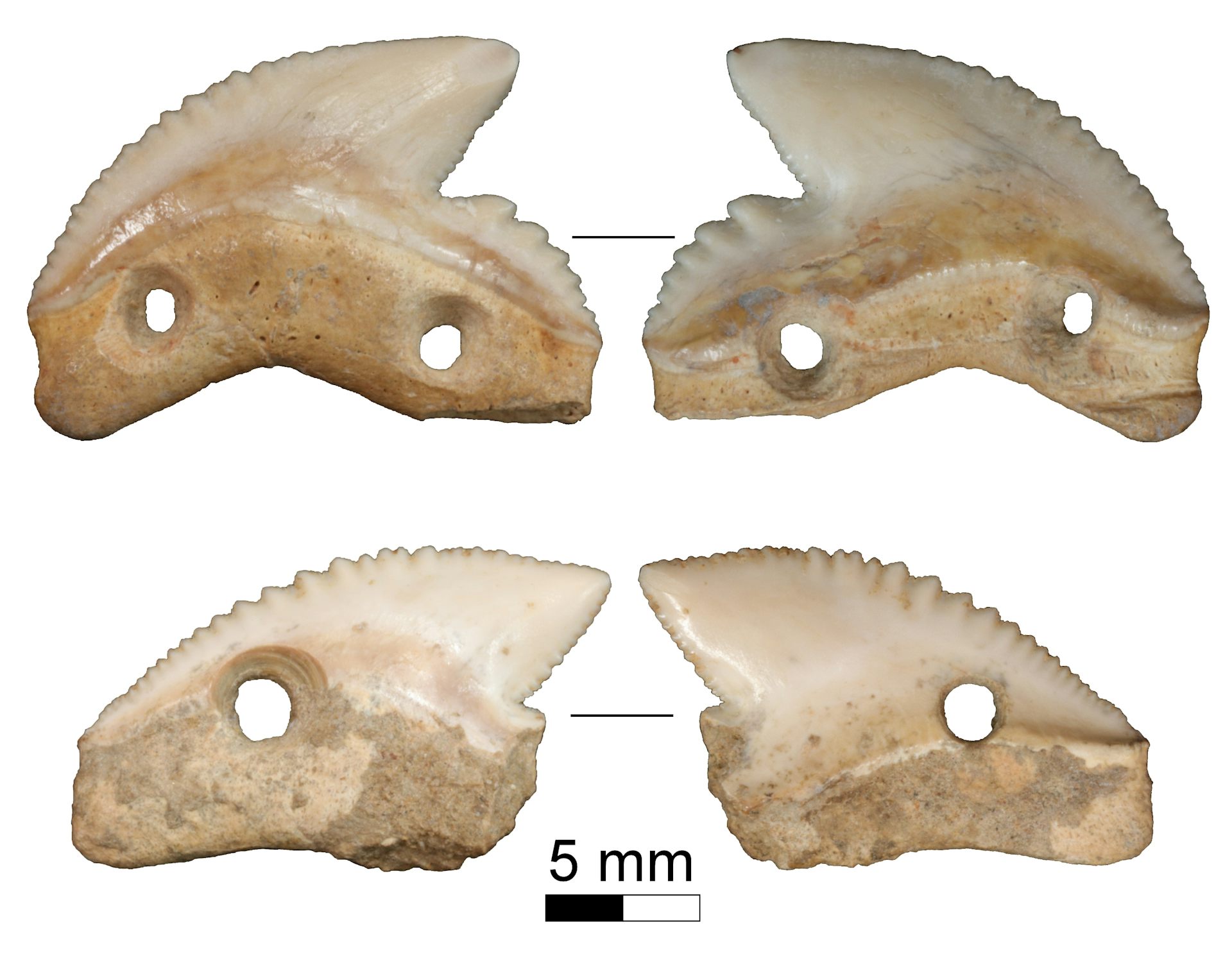
Modified tiger shark teeth found in 7,000-year-old layers of Leang Panninge (top) and Leang Bulu’ Sipong 1 (bottom) on the Indonesian island of Sulawesi.
Credit: M.C. Langley
7,000-year-old teeth
The two shark teeth were recovered during excavations as part of a joint Indonesian-Australian archaeological research program. Both specimens were found in archaeological contexts attributed to the Toalean culture – an enigmatic foraging society that lived in southwestern Sulawesi from around 8,000 years ago until an unknown period in the recent past.
The shark teeth are of a similar size and came from tiger sharks (Galeocerda cuvier) that were approximately two metres long. Both teeth are perforated.
A complete tooth, found at the cave site of Leang Panninge, has two holes drilled through the root. The other – found at a cave called Leang Bulu’ Sipong 1 – has one hole, though is broken and likely originally also had two holes.
Microscopic examination of the teeth found they had once been tightly fixed to a handle using plant-based threads and a glue-like substance. The adhesive used was a combination of mineral, plant and animal materials.
The same method of attachment is seen on modern shark-tooth blades used by cultures throughout the Pacific.
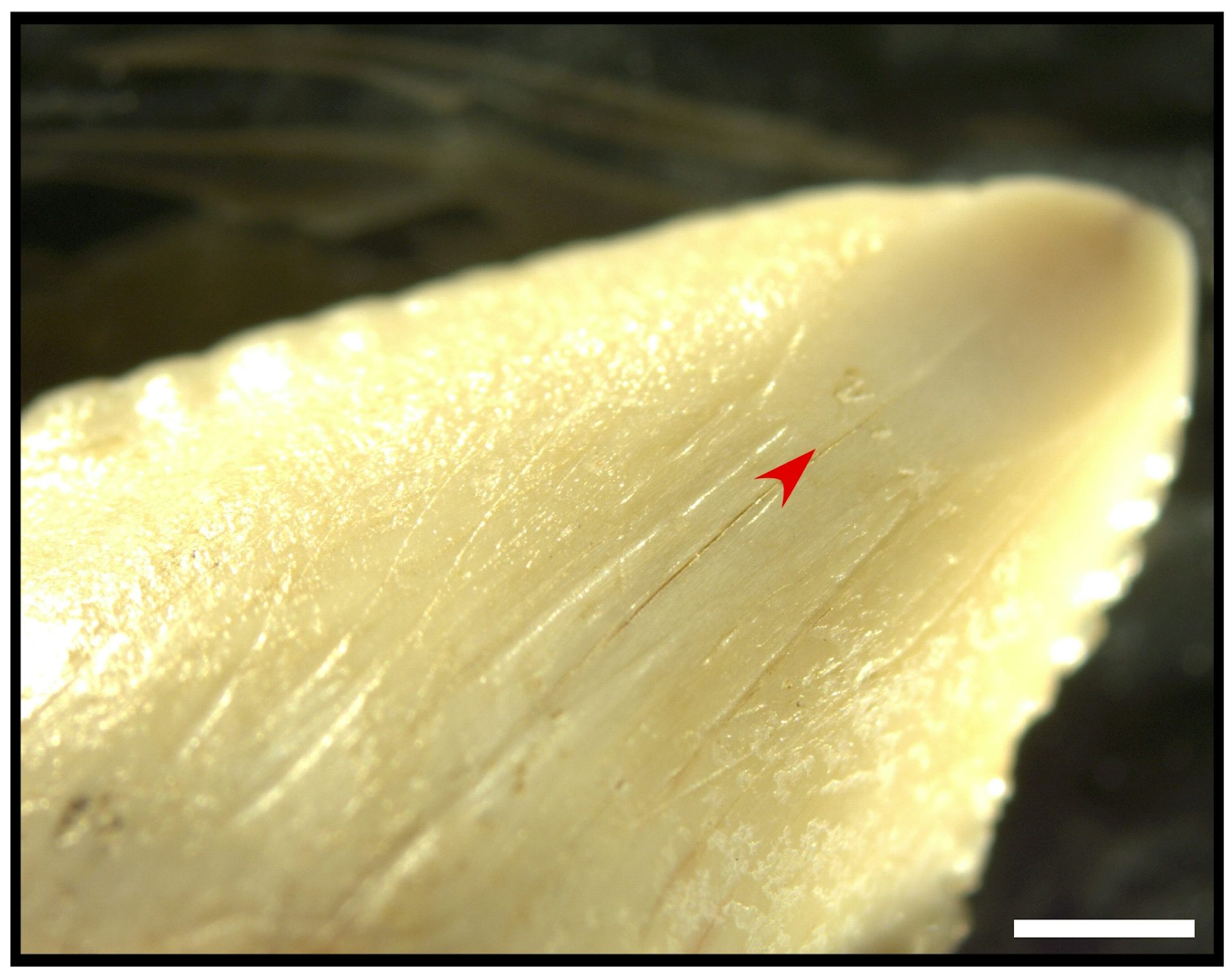
Scratches and a ground section on the tip of the Leang Panninge shark tooth indicate its use by people 7,000 years ago.
Credit: M.C. Langley
While these residues superficially suggest Toalean people were using shark-tooth knives as everyday cutting implements, ethnographic (observations of recent communities), archaeological and experimental data suggest otherwise.
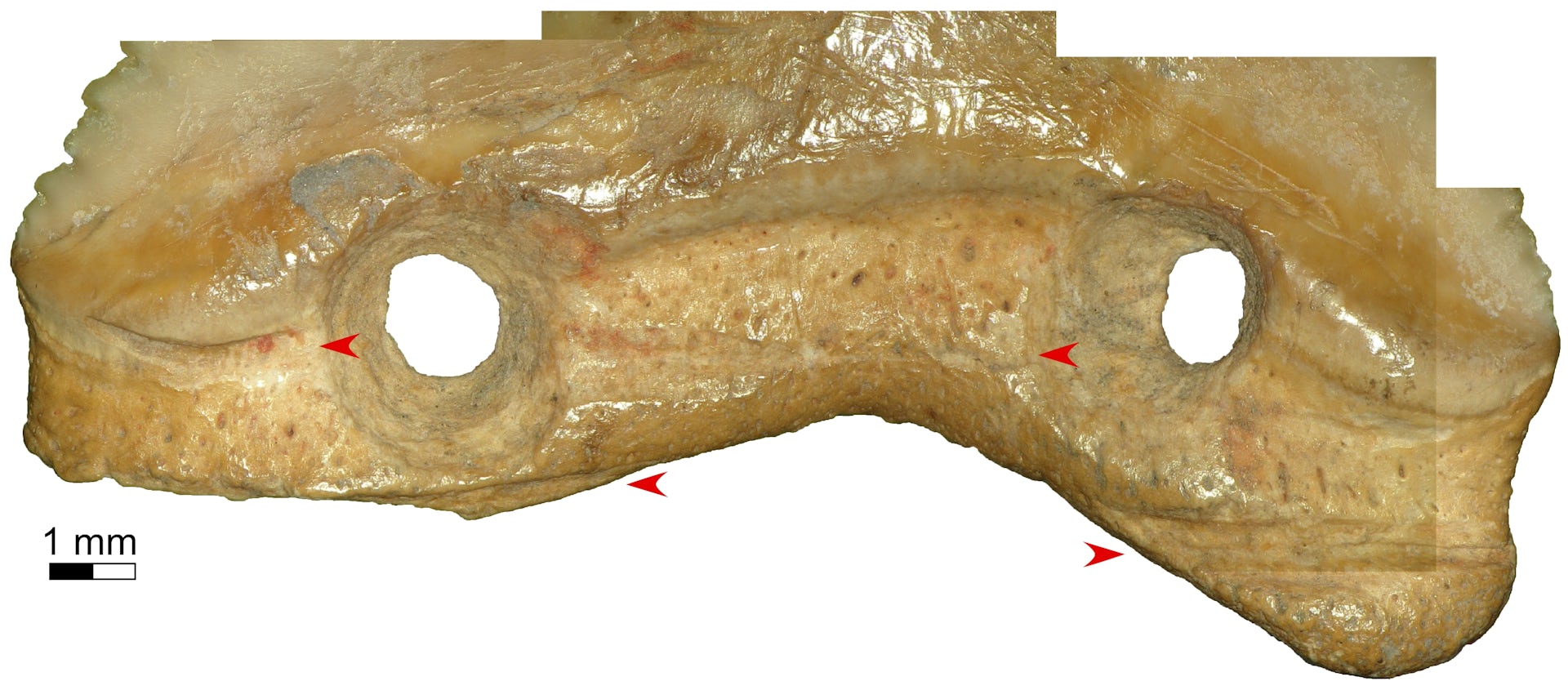
Grooves and traces of red resin along the base of the Leang Panninge tooth show how the teeth were attached using threads.
Credit: M.C. Langley
Not surprisingly, our experiments found tiger shark-tooth knives were equally effective in creating long, deep gashes in the skin when used to strike (as in fighting) as when butchering a leg of fresh pork.
Indeed, the only negative aspect is that the teeth blunt relatively quickly – too quickly to make their use as an everyday knife practical.
This fact, as well as the fact shark teeth can inflict deep lacerations, probably explains why shark-tooth blades were restricted to weapons for conflict and ritual activities in the present and recent past.
Shark-tooth blades in recent times
Numerous societies across the globe have integrated shark teeth into their material culture. In particular, peoples living on coastlines (and actively fishing for sharks) are more likely to incorporate greater numbers of teeth into a wider range of tools.
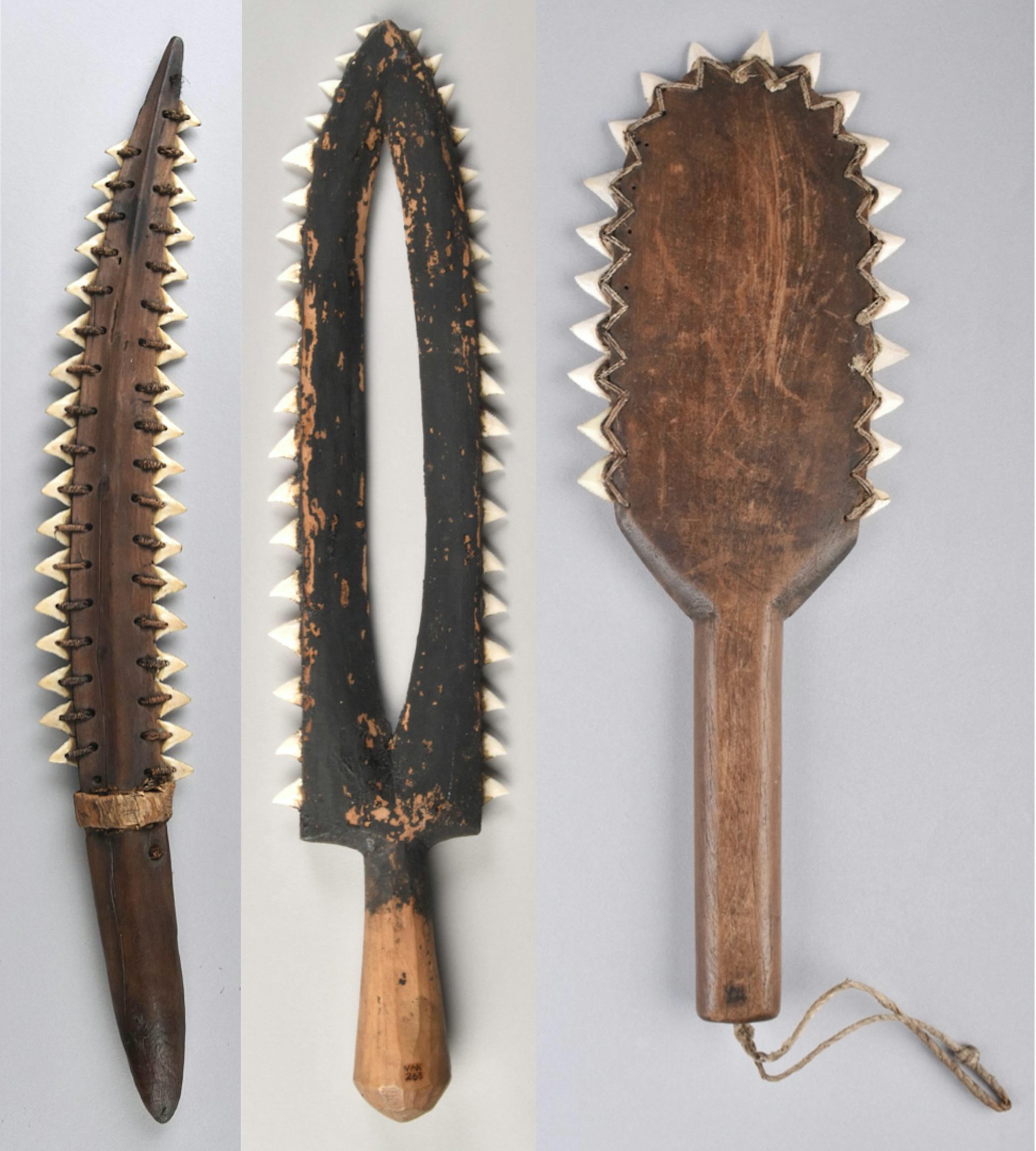
Shark teeth are widely used to edge deadly combat weapons or powerful ritual blades in the Pacific. Left: a knife from Kiribati; centre and right: weapons from Hawai'i.
For example, a fighting knife found throughout north Queensland has a single long blade made from approximately 15 shark teeth placed one after the other down a hardwood shaft shaped like an oval, and is used to strike the flank or buttocks of an adversary.
Weapons, including lances, knives and clubs armed with shark teeth are known from mainland New Guinea and Micronesia, while lances form part of the mourning costume in Tahiti.
Farther east, the peoples of Kiribati are renowned for their shark-tooth daggers, swords, spears and lances, which are recorded as having been used in highly ritualised and often fatal conflicts.
Shark teeth found in Maya and Mexican archaeological contexts are widely thought to have been used for ritualised bloodletting, and shark teeth are known to have been used as tattooing blades in Tonga, Aotearoa New Zealand, and Kiribati.
In Hawai‘i, so-called “shark-tooth cutters” were used as concealed weapons and for “cutting up dead chiefs and cleaning their bones preparatory to the customary burials”.

A shark-tooth knife from Aua Island, Papua New Guinea. Red arrows highlight wear and damage caused by fighting.
Credit: M. Langley and The University of Queensland Anthropology Museum
Almost all shark-tooth artefacts recovered globally have been identified as adornments, or interpreted as such.
Indeed, modified shark teeth have been recovered from older contexts. A solitary tiger shark tooth with a single perforation from Buang Merabak (New Ireland, Papua New Guinea) is dated to around 39,500–28,000 years ago. Eleven teeth with single perforations from Kilu (Buka Island, Papua New Guinea) are dated to around 9,000–5,000 years ago. And an unspecified number of teeth from Garivaldino (Brazil) is dated to around 9,400–7,200 years ago.
However, in each of these cases the teeth were likely personal ornaments, not weapons.
Our newly described Indonesian shark tooth artefacts, with their combination of modifications and microscopic traces, instead indicate they were not only attached to knives, but very likely linked to ritual or conflict.
Whether they cut human or animal flesh, these shark teeth from Sulawesi could provide the first evidence that a distinctive class of weaponry in the Asia-Pacific region has been around much longer than we thought.
Michelle Langley, Associate Professor of Archaeology, Griffith University; Adam Brumm, Professor, Griffith University; Adhi Oktaviana, PhD Candidate, Griffith University; Akin Duli, Professor, Universitas Hasanuddin, and Basran Burhan, PhD candidate, Griffith University
This article is republished from The Conversation under a Creative Commons license. Read the original article.
AbstractOther than lying about science or blatantly misrepresenting it, I've yet to see a coherent explanation for why so much of Earth's history pre-dates the creation cult's 'Creation Week'.
Although first identified 120 years ago, knowledge of the Toalean technoculture of Middle Holocene Sulawesi, Indonesia, remains limited. Previous research has emphasised the exploitation of largely terrestrial resources by hunter-gatherers on the island. The recent recovery of two modified tiger shark teeth from the Maros-Pangkep karsts of South Sulawesi, however, offers new insights. The authors combine use-wear and residue analyses with ethnographic and experimental data to indicate the use of these artefacts as hafted blades within conflict and ritual contexts, revealing hitherto undocumented technological and social practices among Toalean hunter-gatherers. The results suggest these artefacts constitute some of the earliest archaeological evidence for the use of shark teeth in composite weapons.
 Figure 1. Map with (inset) the location of Leang Panninge and Leang Bulu’ Sipong 1image by K. Newman.
Figure 1. Map with (inset) the location of Leang Panninge and Leang Bulu’ Sipong 1image by K. Newman. Figure 2. Archaeological contexts of the perforated shark teeth: a) Leang Panninge cave; b) cave entrance at Leang Bulu’ Sipong 1, at the foot of the isolated limestone karst tower; c) stratigraphic profile, Leang Panninge (2019); d–e) stratigraphic profiles, Leang Bulu’ Sipong 1 (2018); f) Maros point excavated from Leang Bulu’ Sipong 1 (Square T9S1) above the Toalean-associated layer that yielded the shark tooth (scale bar is 10mm)Photographs and image compilation by Y. Perston.Langley MC, Duli A, Stephenson B, et al.
Figure 2. Archaeological contexts of the perforated shark teeth: a) Leang Panninge cave; b) cave entrance at Leang Bulu’ Sipong 1, at the foot of the isolated limestone karst tower; c) stratigraphic profile, Leang Panninge (2019); d–e) stratigraphic profiles, Leang Bulu’ Sipong 1 (2018); f) Maros point excavated from Leang Bulu’ Sipong 1 (Square T9S1) above the Toalean-associated layer that yielded the shark tooth (scale bar is 10mm)Photographs and image compilation by Y. Perston.Langley MC, Duli A, Stephenson B, et al.
Shark-tooth artefacts from middle Holocene Sulawesi.
Antiquity. 2023:1-16. doi:10.15184/aqy.2023.144.
Copyright: © 2023 The authors.
Published by Cambridge University Press on behalf of Antiquity Publications Ltd. Open access
Reprinted under a Creative Commons Attribution 4.0 International license (CC BY 4.0)
We know, for instance that the scientists are using the correct decay rates when they use radiometric dating to determine the age of objects like these shark teeth because creationists assure us that if the basic parameters of the Universe were even slightly different, life would be impossible, yet decay rates depend on two of the four fundamental forces - the weak and strong nuclear forces, so, if they were very different 10,000 years ago by an amount that would make 10,000 years look like 3.8 billion, or 14 billion, or whatever is needed to explain the discrepancy between belief and observable reality, then life would have been impossible when it was supposedly created because quite simply, atoms larger than hydrogen would not have existed because their nuclei would have been unstable.
Creationism must be about the only cult that requires its followers to believe that the vast majority of history occurred when there was no place and no time for it to occur in.
But then these are people who can be made to believe that all life on Earth is descended from a tiny number of ancestors that lived in an unventilated box and got out of it onto a sterile planet on which every living substance had been destroyed (Genesis 7:23), including, presumably, the plants the herbivores needed, the insects the insectivores needed and where most of them would have promptly been exterminated by the carnivores.
Labels:
Archaeology
,
BibleBlunder
,
Creationism in Crisis
,
History
,
Science
Wednesday 13 September 2023
Creationism in Crisis - No-One Mourns For The Old Dead Gods of Arabia - Part 2
The landscape of the mustatil; at the time the mustatil was built, the area was likely wetter than it is today.
Image credit: Wael Abu-Azizeh et al. 2022/RCU
7,000-year-old animal bones, human remains found in enigmatic stone structure in Arabia | Live Science
Archaeologists are uncovering evidence of religious rituals in Norther Arabia, 3000 years before creationists believe Earth and humans were created!
Creationists love to point to the fact that all cultures, ancient and modern, tend to have religion as a central element to the culture, as though that fact somehow proves the locally popular god is real.
Of course, it also points to the fact that we have evolved to 'fail safe' and assume agency where there is none, to naively believe what our parents believe, to accept simplistic answers to complex questions and find it impossible to imagine total oblivion at death.
But, ask a creationists to explain why we should accept the locally popular god is the only real one and all the ancient gods are false, and they will probably cite much of that list as reasons why they had false beliefs, stopping short of going just one god (or one pantheon) further and applying that logic to their own god(s), citing all sorts of nebulous reasons why they believe in their particular god(s).

The team found animal horns from a variety of animals, including cattle and caprines, or animals in the goat family, at the site.
Image credit: Wael Abu-Azizeh et al. 2022/RCU
Did the sun not rise in the morning because they had performed the right rituals? Did the crops not fail when they had failed to chant the right prayers in exactly the right way at the right time, or had broken the rules in some other way?
Did the gods not reward them by helping them prevail in battle or punish them for an assumed transgression when they lost a battle?
And could they too not 'look at the trees' and marvel at the wonders their gods had created? And did their priests not also have the power of prophesy and claim they heard the god(s) speaking to them?
One thing we can be sure about is that belief in their god(s) was a strong motivation for rituals associated with life, death and probably animal husbandry, as it is for believers today. The evidence for that is in the artifacts they left behind as discovered by archaeology, such as that currently going on at al Ula in the Ashar Valley in Northern Arabia, where researchers have now discovered evidence of ritual sacrifice and burials in the remains of stone structures known as mustatils, which are believed to have been used for religious purposes.
To add to the embarrassment for creationists, these structures have been dated to about 7,000 years ago, i.e., some 3,000 years before Earth and humans were created!
Regular readers may recall how the archaeological site in Northern Arabia, close to the Fertile Crescent was the subject of a blog post here last March. Now the Royal Commission for AlUla (RCA), set up to investigate the site, has produced an update. It concerns the remain, both animal and human, found in some of the graves associated with the buildings.
As the RCA news release reports:
Labels:
Anthropology
,
Archaeology
,
History
,
Religion
,
Science
,
Sociology
,
Superstition
Saturday 22 July 2023
Lesson from France - Massacre of the Cathars of Carcassonne, or How Christians Settled Theological Differences
Slideshow code developed in collaboration with ChatGPT3 at https://chat.openai.com/
We've just spent a day in Carcassonne, in southern France, just north of the Spanish border. It's a place every Christian should visit as a reminder of the blood-soaked history of their religion because Carcassonne was the site of one of the most brutal periods of Catholic history until the conquest of the Americas, the Albigensian Crusade.
The Albigensian crusade was conducted on the orders of Pope Innocent III, surely one of the most misnamed Popes in history; a crusade with the objective of nothing less than a total genocide of the Cathars and their religion.
The technique put into practice many of the methods used to terrorize populations and force them into submission that had been developed in the Crusades against the Moslems of the Eastern Mediterranean, where the method was to promise land to the barons and noblemen who led the armies, and the spoils of looting and pillage to the mobs of mercenaries that comprised to soldiery. There were no provisions for feeding and supplying the rag-taggle mobs as they raged through the countryside, so they had to take wheat they needed from the local populations. Towns and villages were ransacked, and the inhabitants slaughtered as a matter of routine.
And bloodletting was encouraged and glorified, to the extent that one observer recorded enthusiastically how the streets of Jerusalem were ankle-deep in blood when the Christian mob over-ran it.
The origins of Catharism are somewhat obscure, as it contained several different ideas fused into a loose system of beliefs with no central authority, so it tended to vary in different communities. A central idea was the essentially Gnostic belief in two gods - a good god of the spiritual domain and an evil god (Satan) who created the physical world and trapped angels inside human bodies. The creator (evil) god was the god of the Old Testament and the good god was the god of the New Testament, who Jesus was sent to tell us about. Escape from the physical world was through death and a special form of baptism to enable reunion with the god of the spiritual realm.
Like Catholicism does today, Catharism was obsessed with sex and saw sexual intercourse as sinful unless performed in the prescribed manner and pre-blessed by a priest in a special ceremony.
A consequence of their belief that the physical world was the domain of Satan and created by him to keep people away from God, was that everything to do with sexual intercourse was to be avoided because it produces more physical reality and more angels trapped in human bodies, so they were Pescatarians, believing that meat, cheese, milk and eggs were the result of sexual intercourse, but fish spontaneously generated and thus were safe to eat. The general disapproval of sexual intercourse caused some obvious problems for some Cathar communities, but others had found a way round it in a legend that the origins of the battle between good and evil in Heaven was because Satan had seduced one of God's wives (he has two, apparently), or maybe it was God who seduced one of Satan's two wives. This was sufficient evidence that God has sexual intercourse, so doesn't prohibit it.
Labels:
Christanity
,
Christians
,
Humanism
,
Morality
,
Secularism
,
Theology
Saturday 18 March 2023
Old Dead Gods - No-One Mourns for the Old Dead Gods of Arabia
Old Dead Gods
No-One Mourns for the Old Dead Gods of Arabia
No-One Mourns for the Old Dead Gods of Arabia
Mustatil ('rectangles") in the heart of Al-Nafūd Desert, Northern Saudi Arabia, are the remains of religious buildings from 7,000 years ago
Enigmatic ruins across Arabia hosted ancient ritual sacrifices
Long before a clan of camel herders and traders along the western edge of Arabia were forced by tribal loyalty to follow a new, charismatic 'Prophet of Allah", and long before a tribe of Canaanite hill farmers in the hill of southern Syria adopted the god Yahweh from the local pantheon as their own, and created a mythical history to give them a unique identity and justify their land-theft, genocide and territorial expansion, scattered bands of early pastoralists had banded together to build hundreds of massive monuments for religious rituals in the Al-Nafūd Desert in the north of Arabia, close to the Western end of the 'fertile crescent'.
1 of 11
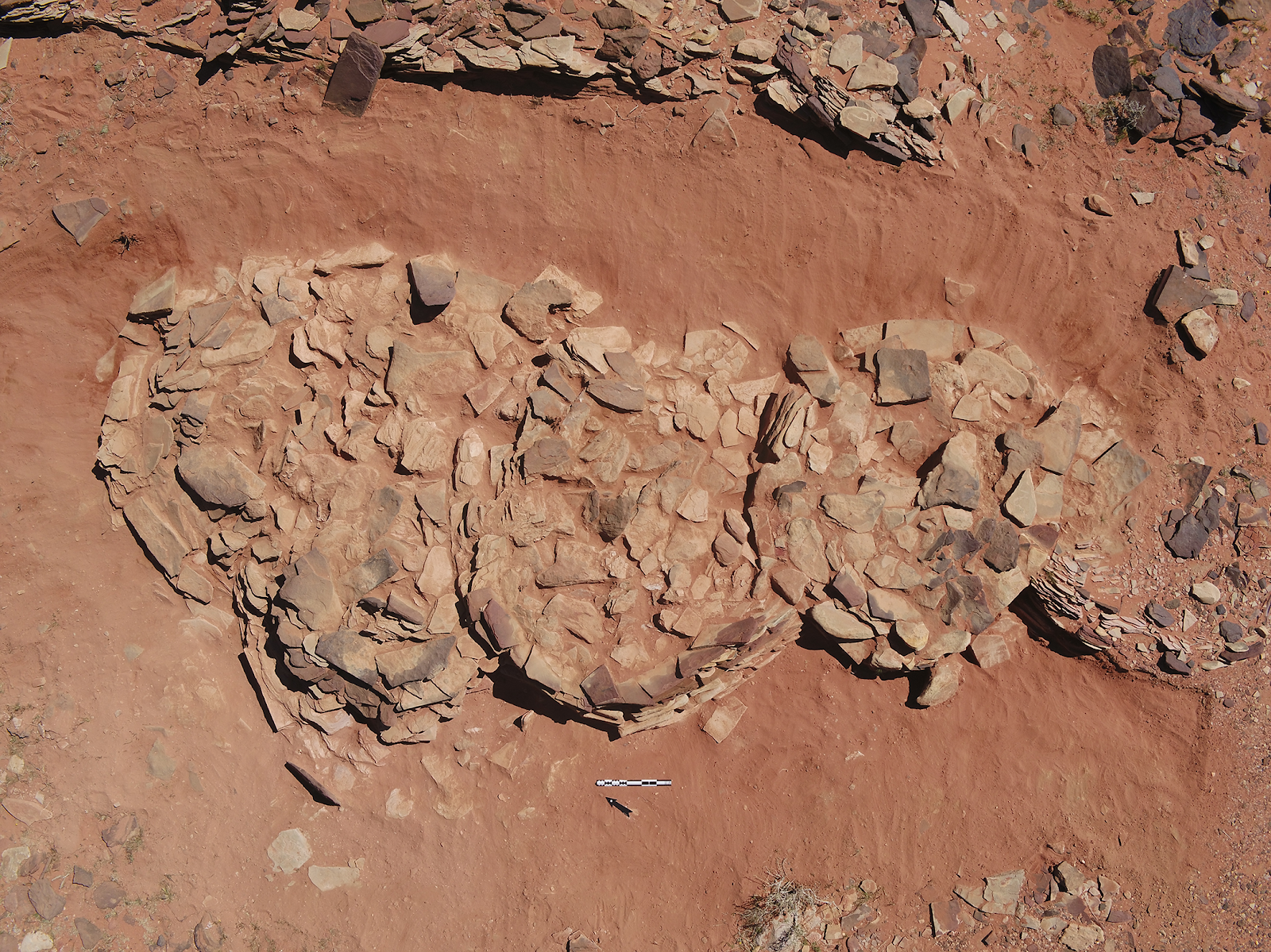
Detail of north-west (preserved) interlocking cells of associated feature IDIHA-F-0011149.
2 of 11

The four I-type platforms located west of IDIHA-F-0011081, photo orientated west.
3 of 11

The main (central) chamber of mustatil IDIHA-F-0011081 with three up-right stones (A-C). Flat stones in centre of image acted as support for primary up-right stone in the rear. The blocked doorway is visible in the left of the photo.
4 of 11

Transverse grooved hammer stone found upside down and in situ in Phase 1.
5 of 11

Bos sp. horn (#0032) recovered from Phase 4A, note the positioning in relation to up-right stone A.
6 of 11

Horns found on a collapsed “bench” in Phase 4B. Left to right, large cattle horns/sheaths (#0043) and (#0033), goat horn sheath (#0047), goat (#0041), and cattle horn (#0040).
8 of 11

Riverstone surface associated with courtyard, further pebbles were set within the doorway.
9 of 11

Two mustatil at site IDIHA-0030862 in Khaybar County orientated (base) towards a body of standing water, photo orientated west.
10 of 11

Three mustatil at site IDIHA-0030914, orientated (base) towards a small seasonal wadi in Khaybar County, photo orientated south-west.
11 of 11

Mustatil IDIHA-F-0011081 orientated (head) towards a playa located to the east, photo orientated east.
They are also associated with elaborate rock-carvings of strange geometric shapes and patters, which were probably originally painted.
As with the Pyramids and the Bronze Age structures of Stonehenge and Silbury Hill, in Wiltshire, UK, they suggest an organised state with an economy strong enough to provide a surplus wealth and food production sufficient to finance these constructions and feed the workers.
And yet, because they left no records, like the religion that inspired the building of Knossos in Minoan Create, we have no idea what that religion was or why it was able to inspire the creation of these structures for the rituals that were performed there, and why the people living there considered it necessary and worth all the effort!
Clearly, the god(s) (and it was probably a pantheon of gods, like the neighbouring Mesopotamians had later) had massive imaginary powers, giving the priesthood enormous powers of command and control, and elaborate rituals were considered necessary to appease or thank them. Yet we have no idea what those imaginary powers were, and whatever they were believed to have done, or not done in response to the rituals continued to be done or not done when the rituals ceased, their last believer died, and the monuments crumbled.
Rosa's Laws of Religion:This is a phenomenon that has been repeated time and again throughout human history as religions have come and gone together with their imaginary gods. No one now mourns at the graveside of these old dead gods.
The First Law of Theodynamics:
Gods can be created out of nothing and will disappear without trace.
No-one believes in Mars, Ra, Wodan, Thor or Saturn, and no-one says the rituals that were once essential to keep the seasons coming and going, the crops growing or the Nile flooding, and yet the seasons continue to come and go, the crops grow and the Nile still floods at the right time.
The prayers and rituals that once influenced these old gods are no longer needed, and the natural occurrences that were once 'obviously' caused or created by them are now just as 'obviously' caused or created by different gods in response to different prayers and rituals. And they will still occur when the current batch of gods have been consigned to the graveyard of the gods along with all the others.
What started me thinking in that line, was a recent article concerning the Arabian monuments in The Conversation by Melissa Kennedy, and Hugh Thomas, Lecturers in Archaeology at the University of Sydney. Their article is reprinted here under a Creative Commons licence, reformatted for stylistic consistency. The original can be read here

Enigmatic ruins across Arabia hosted ancient ritual sacrifices
Source: AAKSA / The Royal Commission for AlUla,
Author provided
A group of three mustatil and later Bronze Age funerary pendants on a rocky outcrop, southeast of AlUla County.
Source: AAKSA / The Royal Commission for AlUla,
Author provided
Melissa Kennedy, University of Sydney and Hugh Thomas, University of Sydney
Over the past five years, archaeologists have identified more than 1,600 monumental stone structures dotted across a swathe of Saudi Arabia larger than Italy. The purpose of these ancient stone buildings, dating back more than 7,000 years, has been a puzzle for researchers.
Our excavations and surveys reveal these were ritual structures, constructed by ancient herders and hunters who gathered to sacrifice animals to an unknown deity – perhaps in response to ancient climate change. The study is published in PLOS ONE today.
Desert discoveries
In the 1970s, the first archaeological surveys of northwest Saudi Arabia identified an ancient and mysterious rectangular structure. The sandstone walls of the structure were 95m long, and although it was determined to be unique, no further study of this unusual site was undertaken.
Over the following decades, airline passengers would see similar large “rectangles” dotted across the country. However, it was not until 2018 that one was excavated.
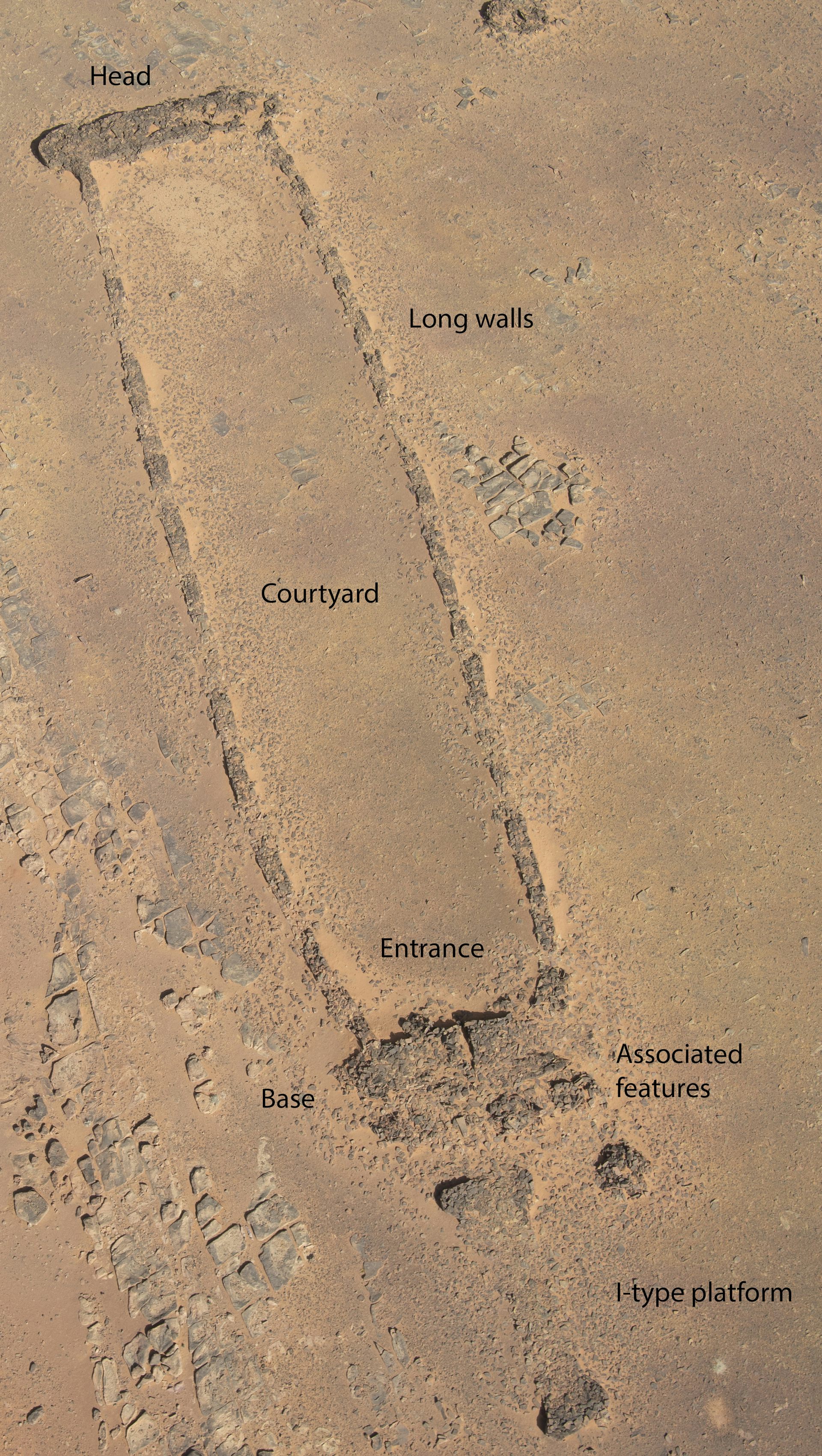
The main architectural features of a mustatil.
Credit: AAKSA /
The Royal Commission for AlUla,
Author provided
The Royal Commission for AlUla,
Author provided
The smallest mustatils are around 20m long, while the largest are over 600m. Previous work by our team determined that all mustatils follow a similar architectural plan. Two thick ends were connected by between two to five long walls, creating up to four courtyards.
Access to the mustatil was through a narrow entrance in the base. There would then have been a long walk, perhaps in the form of a procession, to the “head”, where the main ritual activity took place.
Previous studies determined that the mustatils are at least 7,000 years old, dating to the end of the Neolithic period.
Cattle remains
In 2019–2020, we undertook excavations at a mustatil site called IDIHA-0008222. The structure, made from unworked sandstone, measures 140m in length and 20m in width.
Excavations in the head of the mustatil revealed a semi-subterranean chamber. Within this chamber were three large, vertical stones. We have interpreted these as “betyls”, or sacred standing stones which represented unknown ancient deities.
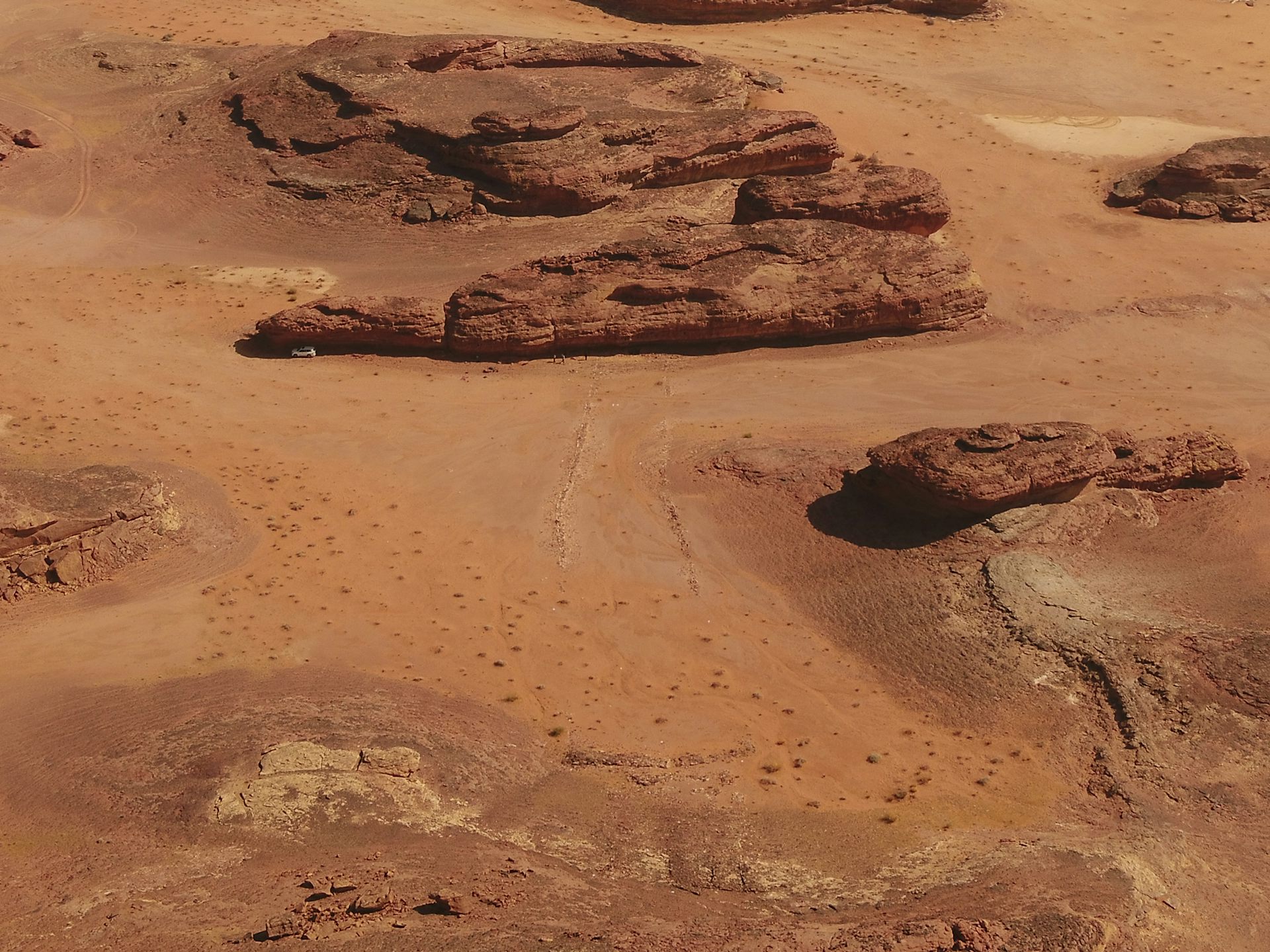
The excavated mustatil at IDIHA-0008222.
Credit: AAKSA / The Royal Commission for AlUla,
Author provided
Author provided
Surrounding these stones were well-preserved cattle, goat, and gazelle horns. The horns are so well preserved that much of what we find is the horn sheath, made of keratin – the same substance as hair and nails. We found only the upper cranial elements of these animals: the teeth, skulls, and horns. This suggests a clear and specific choice of offerings.
Further analysis suggests the bulk of these remains belonged to male animals and the cattle were aged between 2 and 12 years. Their slaughter would have formed a significant proportion of a community’s wealth, indicating these were high-value offerings.
Human remains
Current evidence suggests that the mustatils were in use between 5300 and 4900 BCE, a time when Arabia was green and humid. However, within a few generations, the ancient inhabitants of Saudi Arabia began to reuse these structures, this time to bury human body parts.
At IDIHA-0008222, a small structure had been built next to the mustatil. Inside were a partial foot, five vertebrae and several long bones.
Their placement suggests soft tissue was still present when they were buried. Forensic anthropologists were able to determine that the remains likely belonged to an individual aged between 30 and 40 years.
Our work at other mustatils has revealed similar deposits of human remains. Were these remains buried in attempt to claim ownership of the structure or some form of later ritual? These questions remain to be answered.
Pointing to water
The mustatils are changing how we view the Neolithic period not just in Arabia but across the Middle East. The sheer size of these structures and the amount of work involved in their construction suggests that multiple communities came together to create them, most probably as a form of group bonding.
Moreover, their widespread distribution across Saudi Arabia suggests the existence of a shared religious belief, one held over a vast and un-paralleled geographic distance. Currently, fewer than ten mustatils have been excavated, so our understanding of these structures is still in its infancy.
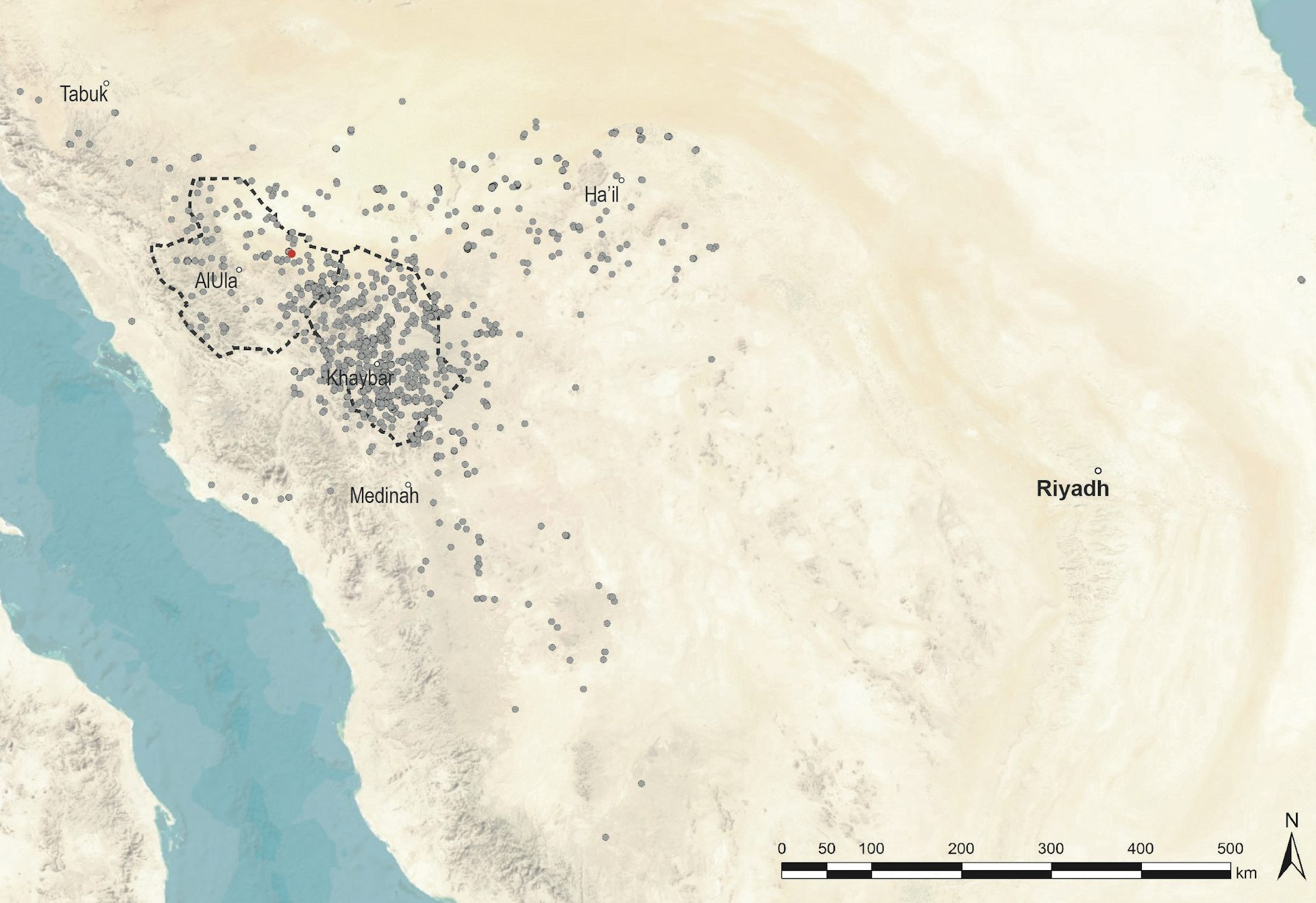
Mustatil locations in Saudi Arabia, with the location of site IDIHA-0008222 marked in red.
Credit: Esri, Maxar, Earthstar Geographics, the GIS User Community, USGS, NOAA /
AAKSA / The Royal Commission for AlUla,
Author provided
AAKSA / The Royal Commission for AlUla,
Author provided
While recording these structures after rain, we noted that almost all mustatils pointed towards areas that held water. Perhaps the mustatils were constructed and the animals offered to the god or gods to ensure the continuation of the rains and the fertility of the land.
The possibility remains that the mustatils were built in response to a changing climate, as the region became increasingly arid like it is today.
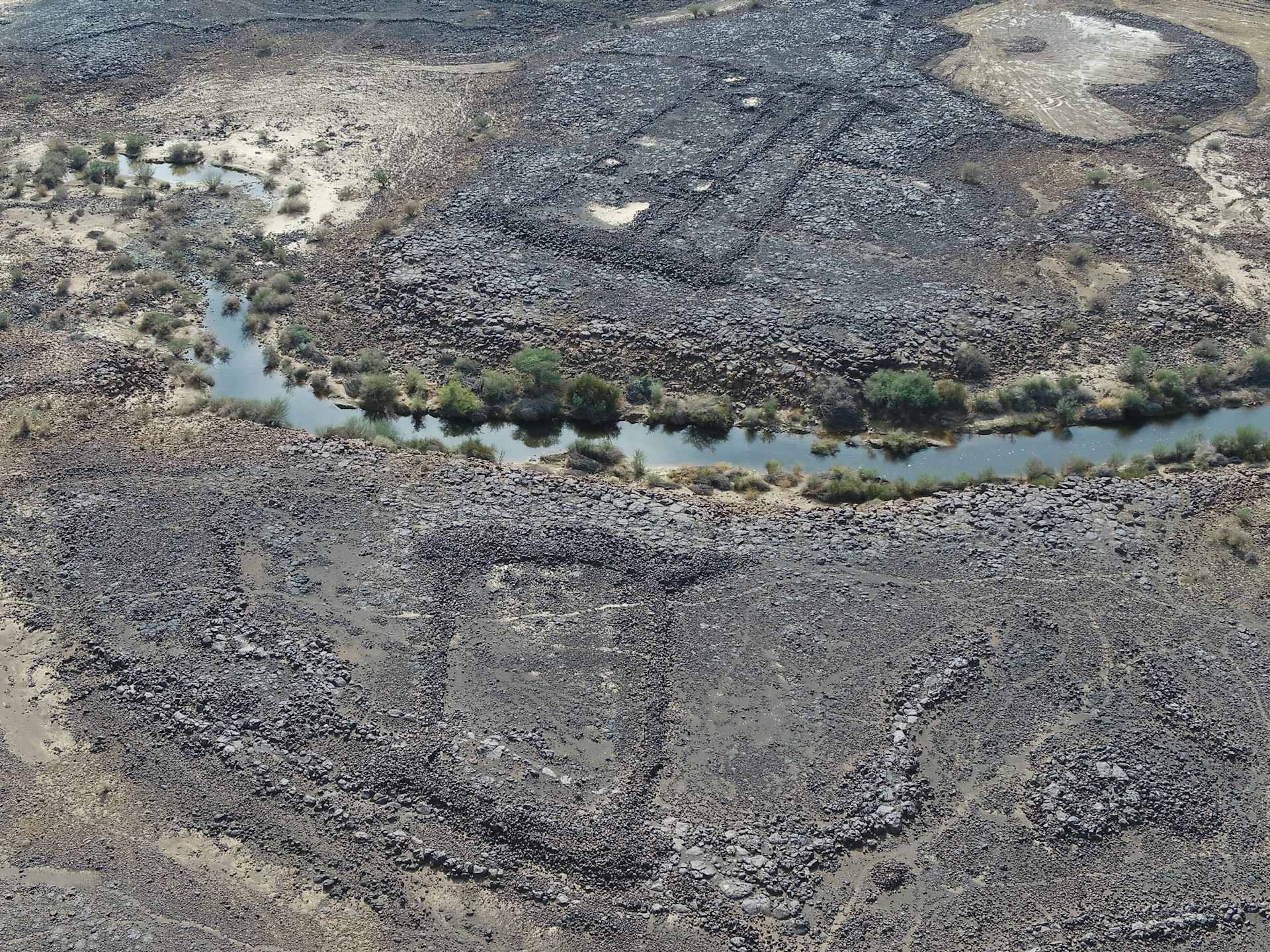
Two mustatil in Khaybar County pointing to standing water after rain.
Credit: AAKSA / The Royal Commission for AlUla,
Author provided
Author provided
We hope future excavations and analyses will reveal further insights into the life and death of the mustatils and the people who built them.
Melissa Kennedy, Lecturer in Archaeology, University of Sydney and Hugh Thomas, Lecturer in Archaeology, University of Sydney
This article is republished from The Conversation under a Creative Commons license. Read the original article.
The paper referred to in the article is published, open access in the online journal PLOS ONE:
AbstractIn the words of H.L.Mechen:
Since the 1970s, monumental stone structures now called mustatil have been documented across Saudi Arabia. However, it was not until 2017 that the first intensive and systematic study of this structure type was undertaken, although this study could not determine the precise function of these features. Recent excavations in AlUla have now determined that these structures fulfilled a ritual purpose, with specifically selected elements of both wild and domestic taxa deposited around a betyl. This paper outlines the results of the University of Western Australia’s work at site IDIHA-0008222, a 140 m long mustatil (IDIHA-F-0011081), located 55 km east of AlUla. Work at this site sheds new and important light on the cult, herding and ‘pilgrimage’ in the Late Neolithic of north-west Arabia, with the site revealing one of the earliest chronometrically dated betyls in the Arabian Peninsula and some of the earliest evidence for domestic cattle in northern Arabia.
Kennedy M, Strolin L, McMahon J, Franklin D, Flavel A, Noble J, et al. (2023)
Cult, herding, and ‘pilgrimage’ in the Late Neolithic of north-west Arabia: Excavations at a mustatil east of AlUla.
PLoS ONE 18(3): e0281904. DOI: 10.1371/journal.pone.0281904
Copyright: © 2023 The authors.
Published by PLoS. Open access
Reprinted under a Creative Commons Attribution 4.0 International license (CC BY 4.0)
Where is the graveyard of dead gods? What lingering mourner waters their mounds? There was a day when Jupiter was the king of the gods, and any man who doubted his puissance was ipso facto a barbarian and an ignoramus. But where in all the world is there a man who worships Jupiter today? And what of Huitzilopochtli? In one year—and it is no more than five hundred years ago—fifty thousand youths and maidens were slain in sacrifice to him. Today, if he is remembered at all, it is only by some vagrant savage in the depths of the Mexican forest. Huitzilopochtli, like many other gods, had no human father; his mother was a virtuous widow; he was born of an apparently innocent flirtation that she carried on with the sun. When he frowned, his father, the sun, stood still. When he roared with rage, earthquakes engulfed whole cities. When he thirsted he was watered with ten thousand gallons of human blood. But today Huitzilopochtli is as magnificently forgotten as Alien G. Thurman. Once the peer of Allah, Buddha and Wotan, he is now the peer of General Coxey, Richmond P. Hobson, Nan Patterson, Alton B. Parker, Adelina Patti, General Weyler, and Tom Sharkey…
But they have company in oblivion: the hell of dead gods is as crowded as the Presbyterian hell for babies. Damona is there, and Esus, and Drunemeton, and Silvana, and Dervones, and Adsalluta, and Deva, and Belisama, and Axona, and Vintios, and Taranuous, and Sulis, and Cocidius, and Adsmerius, and Dumiatis, and Caletos, and Moccus, and Ollovidius, and Albiorix, and Leucitius, and Vitucadrus, and Ogmios, and Uxellimus, and Borvo, and Grannos, and Mogons. All mighty gods in their day, worshiped by millions, full of demands and impositions, able to bind and loose—all gods of the first class, not dilettanti. Men labored for generations to build vast temples to them—temples with stones as large as hay-wagons. The business of interpreting their whims occupied thousands of priests, wizards, archdeacons, evangelists, haruspices, bishops, archbishops. To doubt them was to die, usually at the stake. Armies took to the field to defend them against infidels: villages were burned, women and children were butchered, cattle were driven off. Yet in the end they all withered and died, and today there is none so poor to do them reverence. Worse, the very tombs in which they lie are lost, and so even a respectful stranger is debarred from paying them the slightest and politest homage.
H.L. Menchen "Memorial Service".
Labels:
Archaeology
,
Atheism
,
History
,
Mythology
,
Religion
Saturday 4 March 2023
Creationism in Crisis - 30 Thousand Years of European Hominin History
Creationism in Crisis
30 Thousand Years of Continuous European Human History
30 Thousand Years of Continuous European Human History
Depiction of the people of the Ice Age.
Credit: Esteban De Armas/Shutterstock
We thought the first hunter-gatherers in Europe went missing during the last ice age. Now, ancient DNA analysis says otherwise
It's another bad day for Creationism. Close on the news that scientists have reconstructed the last 100 million years of the history of Earth's surface, comes news that a different group of scientists have revealed the last 30,000 years of the history of Homo sapiens in Europe.
Since Creationists are capable of holding to the belief that Earth is only 10,000 years old because ancient Bronze Age nomads who knew no better thought so, despite the fact that the last 100 million years of its history is known in detail, they should have little difficulty in ignoring the evidence that Europeans have a known history stretching back three times longer than they believe Earth has existed. After all, what is a mere 30,000 years when 100 million years can be ignored?
In fact, we know from fossil evidence that early modern human hunter-gatherers spread out of Africa and across Eurasia beginning about 45,000 years ago. The mystery was what happened to them during period between 25,000 and 19,000 years ago when the last Ice Age was at its maximum and much of Europe was under vast ice sheets like that covering Greenland today.
Some authorities believed that European Homo sapiens disappeared during that time, but this recent research shows that they hung on in France and the Iberian Peninsula, to repopulate Europe as the ice sheets retreated north. The evidence is in the traces of their DNA now found in modern Europeans. The scientists who made this discovery have published their work in two papers, one in Nature and the other in Nature, Ecology & Evolution
One of the authors of these papers, Adam B. Rohrlach of the Department of Archaeogenetics, Max Planck Institute for Evolutionary Anthropology, Leipzig, Germany and the School of Mathematical Sciences, University of Adelaide, Adelaide, South Australia, Australia, has written about the team's research in The Conversation. His article is reprinted here under a Creative Commons licence, reformatted for stylistic consistency. The original article can be read here.
Labels:
Anthropology
,
Archaeology
,
Creationism in Crisis
,
History
,
Science
Monday 31 January 2022
The Old Dead Gods of Wiltshire are Still Hiding Their Secrets
How science is uncovering the secrets of Stonehenge | Heritage | The
Guardian
Rosa's Laws of Theodynamics.
But to their believers, as we can see by the evidence of the resources they devoted to them, they would have been no less important and no less 'proven' than are the modern gods of present days religions. The evidence for them would have been 'all around them'. It would have been in the 'design' of trees, sunsets and flowers and in the way they always answered prayers like ensuring the sun rose in the morning and the crops continued to grow in the fields, and when they failed this was proof of the failure of their followers to pray hard enough or to believe with enough faith or not having performed the required ritual correctly, or because the god(s) said no, for reasons which could only be guessed at.
Rosa's Laws of Theodynamics.
The vast complex of Late Bronze/Early Iron Age monuments, burial chambers and earthworks on Salisbury Plain, in central southern England about which I've written before, continue to remind us how, when a religion and its god(s) disappear into the mists of time and no-one remembers them, unlike a science could be, they cannot be reconstructed from real-world sources, because they were never founded on real-world sources in the first place. They arose entirely in the imaginations of people who lacked the scientific method to discover the truth about the world about them.First Law of Theodynamics
Gods can be created out of nothing and will disappear without trace.
Tweet
Third Law of Theodynamics
Gods disappear completely when the number of believers in them reaches zero.
Tweet
But to their believers, as we can see by the evidence of the resources they devoted to them, they would have been no less important and no less 'proven' than are the modern gods of present days religions. The evidence for them would have been 'all around them'. It would have been in the 'design' of trees, sunsets and flowers and in the way they always answered prayers like ensuring the sun rose in the morning and the crops continued to grow in the fields, and when they failed this was proof of the failure of their followers to pray hard enough or to believe with enough faith or not having performed the required ritual correctly, or because the god(s) said no, for reasons which could only be guessed at.
Labels:
Anthropology
,
Atheism
,
History
,
Religion
,
Sociology
Tuesday 27 April 2021
New York Religions - Trying to Solve the Problems Religions Cause.

Dec 11, 2019. Orthodox Jewish men pass New York City police guarding a Brooklyn synagogue prior to a funeral for Mosche Deutsch, a rabbinical student from Brooklyn who was killed in a shooting at a market in Jersey City, N.J.
Credit: AP Photo/Mark Lennihan
Concerned by the rising tide of inter-faith tension and hate resulting in violent attacks on members of one faith by members of another, a group of New York's faith organizations have got together to try to solve the problem faiths are causing.
According to a report in Religion News Service:
On April 16, clergy from 20 New York congregations, including Muslims, Hindus, Buddhists, Jews and Christians, met as the Interfaith Security Council held its first meeting to talk about how to share expertise and improve relations with law enforcement.This was prompted by, amongst other incidents, the mass shooting in Pittsburg, PA, in October 2018, when a gunman attacked worshippers at the Tree of Life Synagogue, killing 11 people, vandalism at four synagogues in the Riverdale neighbourhood of Bronx, NY, last week, and the killing of Mosche Deutsch, a rabbinical student from Brooklyn in Jersey City, N.J. on Dec 11, 2019. Armed police had to be deployed at the Brooklyn synagogue where his funeral took place.
The Interfaith Security Council is an umbrella organisation bringing together several other religious security organizations, one of which is 67th Precinct Clergy Council of Brooklyn, which supports mostly churches in the borough’s East Flatbush area. It's president, Pastor Gilford Monrose, of Mt. Zion Church of God 7th Day, blamed white supremacists for the escalating level of inter-faith violence with:
Labels:
Atheism
,
Humanism
,
Religion
,
Religious Violence
,
USA
Tuesday 16 February 2021
Old Dead Gods - Stonehenge Rebuilt
 |
| Stonehenge, Wiltshire, UK |
Stonehenge, that ancient monument in the middle of the Salisbury Plain in Wiltshire, England, may have been built first, about 5,000 years ago, in the Preseli Hills of South Wales, and then been dismantled, transported to its present site and re-erected. This is the conclusion of archaeologists from University College London (UCL) who have published a paper in the journal Antiquity.
The smaller, inner, stones or 'blue stones' are already known to have come from the Preseli Hills and to have been erected before the larger, outer ring of local 'sarsen' stones was erected. Now archaeologists led by Professor Mike Parker Pearson of the UCL Institute of Archaeology, have identified an ancient quarry and the remains of a stone circle nearby, which may have been dismantled and transported 140 miles away, possibly by migrants.
Labels:
Archaeology
,
Atheism
,
History
,
Religion
Subscribe to:
Posts
(
Atom
)

